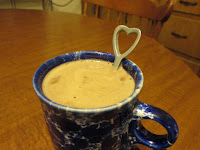So this week, Brian whipped up another batch of oat milk specifically to test for this use. This time, he soaked the oats first for around half an hour, then blended them and strained them, but added no sweetener. Then he instructed me to make a cup of cocoa just as I usually do: mix 1 tsp. cocoa, 1 tsp. sugar, and half a packet of sweetener in the mug, add enough boiling water to make a paste, stir in the milk, zap it for one minute in the microwave, and trickle in a few drops of vanilla.
 Here you see the cocoa just as it looked when it first came out of the microwave. Although you probably can't tell from the photo, it was already quite thick at this point; stirring it with the spoon felt rather like spooning up a thick soup. It also required an extra spoonful of sugar to make it as sweet as cocoa made with milk. With that addition, it was drinkable, and the flavor of the oat milk didn't noticeably alter its taste.
Here you see the cocoa just as it looked when it first came out of the microwave. Although you probably can't tell from the photo, it was already quite thick at this point; stirring it with the spoon felt rather like spooning up a thick soup. It also required an extra spoonful of sugar to make it as sweet as cocoa made with milk. With that addition, it was drinkable, and the flavor of the oat milk didn't noticeably alter its taste.However, over the course of the next few minutes, the cocoa continued to thicken, to the point that its started to feel more like a semi-solid mixture, similar to applesauce, than any sort of liquid. Not only did it get harder to sip, it developed an almost slimy mouthfeel that was rather unpleasant. Before too long I handed over the cup to Brian, saying I just couldn't finish it—and before he was halfway through it, he also gave up the attempt, giving the lie to his earlier claim that he "could eat anything."
So it's apparent that this recipe for homemade oat milk won't work for us. Brian could use it on his cereal, but there's not that much point in switching over to a plant-based milk just for him when I'm the one who's most interested in getting off the moo juice. The question now is, could any other form of oat milk possibly work?
A little research suggested that a commercial oat milk, such as Oatly, probably wouldn't have this same problem with excessive thickening. According to the Plant Milk website, homemade oat milk
"contain[s] natural fiber (mucilage) which function as natural thickener." However, when commercial oat milks are pasteurized, "these substances (mucilages) disappear along with many other nutrients." The authors of the site try to make it sound like this thickness is a feature, not a bug, arguing it's what gives oat milk its "personality." They also claim that oat milk made according to the "basic recipe" (50 grams of rolled oats to one liter hot water) should be "substantial, but not overly thick when warmed up for consumption"—which wasn't our experience at all.
However, the site also concedes that if you want a thinner milk, you can either reduce the amount of oats, use cooler water, or let the oats sit in the hot water overnight as it cools. Unfortunately, I'm skeptical about these claims, given that we actually did use cold water in our oat milk and it still came out so thick as to be undrinkable.
There's also a recipe on this site for Raw Grain Oat Milk, which uses oats blended with hot water—without pre-soaking—and then heats the resulting mixture for ten minutes before refrigerating it. This version, the site claims, "will keep its creamy texture without being too thick" when reheated. And on the section of the site devoted to hot chocolate recipes, it notes that hot chocolate made with other versions of oat milk become "pudding-like" as they cool, but it claims this version "won’t get too thick sitting on the fridge."
So I suppose we could try this recipe to see if it works any better in cocoa, but I'm not sure it's really worth the attempt. For one thing, this site already steered us wrong on its basic oat milk recipe, so I'm not all that inclined to trust it about the "raw grain" version. And even if this form of oat milk proves to be usable, the added step of heating the milk before storing it makes for considerably more work—more than we would probably want to go to every time we needed milk to drink. (I guess it's not really more work than going out to the store for milk, but when we do that, we can pick up two gallons at a time; this recipe only makes one liter.)
So it looks like it's back to the drawing board on plant-based milks. I found a collection of nine "easy plant milk recipes" on the Simple Vegan blog, but most of them call for nuts, which are pricey. The brown rice milk recipe would be reasonably cheap to make, but it calls for cooking the rice first, which, once again, adds an extra step that makes for a lot more work. The most promising recipe I've found is this semi-homemade coconut milk, which is simply coconut milk (not the same as the refrigerated stuff, which is thinner and costs a lot more) diluted with water. If you use Trader Joe's coconut milk, which costs only 99 cents a can, this recipe works out to only $3.16 per gallon—only around 50 percent more than the cheapest price we've found for dairy milk at Costco, and actually less than we've occasionally paid at Shop-Rite when there wasn't a good sale. So maybe mixing up a batch of that should be our next experiment.




No comments:
Post a Comment